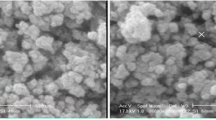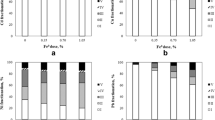Abstract
Chemical immobilisation of inorganic contaminants by increasing the sorption capacity of soils and/or promoting the formation of sparingly soluble precipitates may be a cost-effective approach to counteract groundwater pollution. This study focuses on the enhanced retention of arsenic in two contaminated soils by addition of solid iron(II)sulphate. Four lab-scale column experiments were performed under unsaturated conditions with subsoil material sampled at a former timber preservation site and a pigment production plant. Arsenic effluent concentrations indicated 89.9 to 99.8% immobilisation in the treated columns. Sequential extractions showed a shift in contaminant binding forms towards the iron(hydr)oxide and residual fractions. Possible immobilisation mechanisms are the precipitation of FeAs phases, the formation of inner sphere complexes, and/or the occlusion of arsenic in newly formed amorphous/crystalline iron oxides. Bromide breakthrough curves point to the fact that the addition of iron(II)sulphate only moderately affects soil hydraulic properties. In contrast to reduced emissions of arsenic, increased seepage water concentrations were observed for other trace elements (e.g., cobalt, nickel, zinc). Mass balances indicate that this effect is primarily related to the temporary pH-drop caused by the oxidation of ferrous iron. The results show that chemical immobilisation using iron(II)sulphate is a promising way to protect groundwater quality at sites contaminated with timber preservation and pigment production remnants. As a prerequisite, optimum amendment levels need to be established and practical/field tests should be accompanied by a monitoring for a broad range of relevant trace elements.
Similar content being viewed by others
References
Anonymous: 1995, ‘Vorgehensweise bei Verdacht auf Untergrundkontaminationen durch Holzschutzmittelanwendung’, Texte und Berichte zur Altlastenbearbeitung, Landesanstalt fÜr Umweltschutz Baden-WÜrttemberg, Karlsruhe 21, 52 pp.
Anonymous: 1997, ‘IonplusTM Series Bromide Electrode. Instruction manual’, Orion Research, Inc. Beverly, USA, 56 pp.
Bigham, J. M., Fitzpatrick, R. W. and Schulze, D. G.: 2002, ‘Iron oxides’, in J. B. Dixon and D. G. Schulze (eds.), Soil mineralogy with environmental applications, Soil Science Society of America Book Series 7, Madison, 322–366.
Bothe, J. V. and Brown, P. W.: 1999, ‘Arsenic Immobilization by Calcium Arsenate Formation’, Environ. Sci. Technol. 33, 3806–3811.
Bowell, R. J.: 1994, ‘Sorption of Arsenic by iron oxides and oxyhydroxides in soils’, Applied Geochemistry 9, 279–286.
Brusseau, M., Hu, Q. and Srivastava, R.: 1997, ‘Using flow interruption to identify factors causing nonideal contaminant transport’, J. Contam. Hydrol. 24, 205–219.
Jain, A., Raven, K. P. and Loeppert, R. H.: 1999, ‘Arsenite and Arsenate Adsorption on Ferrihydrite: Surface Charge Reduction and Net OH-Release Stoichiometry’, Environ. Sci. Technol. 33, 1179–1184.
Kim, J.-Y., Davis, A. P. and Kim, K.-W.: 2003, ‘Stabilization of available arsenic in highly contaminated mine tailings using iron’, Environ. Sci. Technol. 37, 189–195.
Ma, L. Q. and Rao, G. N.: 1997, ‘Effects of phosphate rock on sequential chemical extraction of lead in contaminated soils’, J. Environ. Qual. 26, 788–794.
Matera, V. and Le Hécho, I.: 2001, ‘Arsenic behaviour in contaminated soils: mobility and speciation’, in H. M. Selim and D. L. Sparks (eds.), Heavy Metals Release in Soils, Lewis Publishers, Boca Raton, London, New York, Washington DC, 207–235.
McGeehan, S. L. and Naylor, D. V.: 1994, ‘Sorption and Redox Transformation of Arsenite and Arsenate in Two Flooded Soils’, Soil Sci. Soc. Am. J. 58, 337–342.
Mehra, O. P. and Jackson, M. L.: 1960, ‘Iron oxide removal from soils and clays by a dithionite-citrate system buffered with sodium bicarbonate’, Clays Clay Min. 7, 317–327.
Olson, R Ellis, R.: 1965, ‘Iron’, in A. L. Page (ed.), Methods of soil analysis, Part 2. Chemical and microbiological properties, Agronomy Monographs 9, ASA-SSSA, Madison, USA, 310–312.
O’Reilly, S. E., Strawn, D. G. and Sparks, D. L.: 2001, ‘Residence Time Effects on Arsenate Adsorption/Desorption Mechanisms on Goethite’, Soil Sci. Soc. Am. J. 65, 67–77.
Raven, K. P., Jain, A. and Loeppert, R. H.: 1998, ‘Arsenite and arsenate adsorption on ferrihydrite: kinetics, equilibrium and adsorption envelopes’, Environ. Sci. Technol. 32, 344–349.
Shiowatana, J., Tantidanai, N., Nookabkaew, S. and Nacapricha, D.: 2001, ‘A novel continuous-flow extraction procedure for metal speciation in solids’, J. Environ. Qual., 1195–1205.
Stüfen, H. and Schneider, W.: 2002, ‘Impact of different source terms on attenuation factors’, in D. Halm and P. Grathwohl (eds.), Proceedings of the 1st International Workshop on Groundwater Risk Assessment at Contaminated Sites (GRACOS), TÜbinger Geowissenschaftliche Arbeiten C61, 66–71.
Sun, X. and Doner, H.: 1998, ‘Adsorption and oxidation of arsenite on goethite’, Soil Science 163, 278–287.
Sun, X., Doner, H. E. and Zavarin, M.: 1999, ‘Spectroscopy Study of Arsenite [As(III)] Oxidation on Mn-substituted Goethite’, Clays and Clay Minerals 47, 474–480.
Toride, N., Leij, F. J. and VanGenuchten, M. Th.: 1995, ‘The CXTFIT code for estimating transport parameters from laboratory or field tracer experiments, Version 2.1’, Research Print 137, U.S. Salinity Laboratory Riverside, California, 121 pp.
Wehrer, M. and Totsche, K. U.: 2003, ‘Detection of non-equilibrium contaminant release in soil columns: Delineation of experimental conditions by numerical simulations’, J. Plant Nutr. Soil Sci. 166, 475–483.
Weigand, H., Totsche, K. U., Kügel-Knabner, I., Annweiler, E., Richnow, H. H. and Michaelis, W.: 2002, ‘Fate of anthracene in contaminated soil: transport and biochemical transformation under unsaturated flow conditions’, Europ. J. Soil Sci. 53, 71–81.
Williams, L. E., Barnett, M. O., Kramer, T. A. and Melville, J. G.: 2003, ‘Adsorption and Transport of Arsenic(V) in Experimental Subsurface Systems’, J. Environ. Qual. 32, 841–850.
Zeien, H.: 1995, ‘Chemische Extraktionen zur Bestimmung der Bindungsformen von Schwermetallen in Büden (Chemical extractions to identify heavy metal binding forms in soils)’, Bonner Bodenkundliche Abhandlungen 17, 284 pp.
Author information
Authors and Affiliations
Corresponding author
Rights and permissions
About this article
Cite this article
Gemeinhardt, C., Müller, S., Weigand, H. et al. Chemical immobilisation of arsenic in contaminated soils using iron(II)sulphate—advantages and pitfalls. Water Air Soil Pollut: Focus 6, 281–297 (2006). https://doi.org/10.1007/s11267-005-9023-0
Received:
Revised:
Accepted:
Published:
Issue Date:
DOI: https://doi.org/10.1007/s11267-005-9023-0




